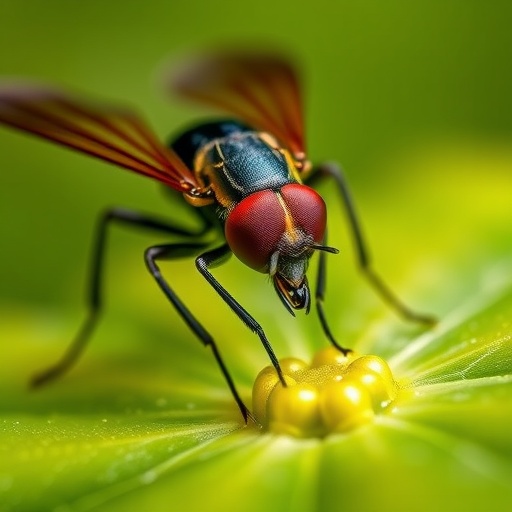In a groundbreaking achievement, researchers at the University of Queensland have captured the first-ever high-resolution, near-atomic 3D structure of a fully mature yellow fever virus particle. This significant advance addresses a long-standing gap in our understanding of a virus responsible for severe liver disease and significant mortality across South America and Africa. By leveraging state-of-the-art cryo-electron microscopy and innovative chimeric viral platforms, the team has illuminated the distinct architectural differences that exist between the vaccine strain and its pathogenic counterparts, offering vital insights into viral structure and immune recognition.
The yellow fever virus (YFV) has posed a persistent challenge to global health due to its capacity for rapid transmission via mosquitoes and its potentially fatal effects on infected individuals. Despite the availability of an effective vaccine developed decades ago, the precise structural biology underlying the virus’s behavior and immunogenicity remained unresolved until now. Utilizing the well-characterized Binjari virus platform pioneered at the University of Queensland, scientists ingeniously fused yellow fever’s structural gene sequences with the benign Binjari virus backbone. This innovative chimera allowed for safe and controlled examination of virus particles under high-resolution imaging conditions without the risks associated with handling virulent strains.
The imaging studies revealed critical differences in the surface topography of the virus particles. Vaccine strain particles, specifically YFV-17D, exhibited a smooth and stable outer shell. In contrast, the virulent strains displayed pronounced, uneven “bumps” on their surfaces. These disparate surface features critically influence how the host immune system perceives and interacts with the virus. The irregular surface on pathogenic strains exposes epitopes that are typically hidden, enabling certain antibodies to bind more effectively. Conversely, the vaccine strain’s smooth structure conceals these antigenic sites, thereby modulating the immune response and contributing to its safety and efficacy profile.
Understanding the architectural distinctions between these strains transcends academic curiosity; it has practical implications for vaccine design and antiviral drug development. By mapping atomic-level differences in virion morphology, scientists can now pinpoint how specific amino acid residues within the envelope protein orchestrate both the shape and antigenicity of the virus. The explicit identification of a single residue modulating these critical features presents an unprecedented opportunity to refine vaccine constructs and might be instrumental in generating next-generation vaccines with enhanced safety or broader protection.
Yellow fever remains a formidable public health concern, notably in endemic areas across tropical regions. While vaccination has drastically reduced disease incidence, occasional outbreaks underscore the need for improved intervention strategies. With no licensed antiviral therapies currently available, insights garnered from this research could pivot future drug discovery efforts toward novel targets within the virion’s structural framework. Such targeted interventions may inhibit viral entry or immune evasion mechanisms, thereby complementing existing prophylactic measures.
One of the most compelling aspects of this research lies in its translational potential for related flaviviruses. Dengue, Zika, and West Nile viruses share structural and genetic similarities with yellow fever virus, posing global health threats of their own. Insights drawn from yellow fever’s mature particle architecture could illuminate common vulnerabilities across these viruses, facilitating the rational design of vaccines and therapeutics that are effective beyond a single pathogen. This cross-applicability attests to the broad impact of high-resolution viral structural biology.
The discovery was facilitated by cryo-electron microscopy, an imaging technique that rapidly revolutionized structural biology by allowing visualization of biomolecules in their natural, hydrated states without the need for crystallization. The ability to resolve structures at near-atomic resolution brings unprecedented clarity to viral morphology and dynamics. Through meticulous sample preparation and advanced image reconstruction algorithms, the researchers generated a detailed 3D map of the virus surface, capturing subtle conformational differences that escape lower-resolution methods.
Crucially, this research underscores the role of envelope proteins in modulating both virion architecture and antigenic profile. The envelope protein governs processes such as viral attachment, membrane fusion, and immune evasion. Identifying the molecular determinants of its shape and exposure illustrates the delicate balance the virus maintains between infectivity and susceptibility to neutralizing antibodies. Such findings enrich our understanding of viral evolution and pathogenesis, elucidating how minor mutations can profoundly alter viral behavior.
The study was led by Dr. Summa Bibby, whose expertise in molecular bioscience and structural chemistry was pivotal in deciphering the molecular intricacies of yellow fever virus architecture. Professor Daniel Watterson, an expert in viral pathogenesis, emphasized the implications of these findings for public health and vaccine innovation. Their combined efforts demonstrate the power of multidisciplinary collaboration, uniting virology, chemistry, and advanced imaging techniques to tackle longstanding biological puzzles.
This pioneering research not only expands the scientific knowledge base on yellow fever virus but also sets a benchmark for structural studies on emerging and re-emerging viral pathogens. The methods and findings provide a template for future investigations exploring how viral proteins dictate morphology and immune response, with potential to accelerate vaccine and antiviral developments globally. As the world grapples with viral pandemics, such detailed molecular insights become invaluable tools in the biomedical arsenal.
The findings were published in the esteemed journal Nature Communications, signifying their high scientific merit and broad relevance to the field of infectious diseases and immunology. The research was supported by the National Health and Medical Research Council, underscoring the importance of funding in enabling cutting-edge scientific discoveries that address urgent public health challenges.
By marrying innovative viral engineering approaches with cutting-edge imaging technology, this work casts new light on yellow fever virus architecture at unprecedented resolution. It reveals how a subtle change in a single amino acid residue can reshape the virion landscape, altering antigen presentation and immune interaction. This atomic-level view of viral morphology offers a roadmap towards next-generation vaccines and therapeutics poised to reduce the global burden of yellow fever and its viral relatives.
Subject of Research: Not applicable
Article Title: A single residue in the yellow fever virus envelope protein modulates virion architecture and antigenicity
News Publication Date: 26-Sep-2025
Web References: https://doi.org/10.1038/s41467-025-63038-5
References: Bibby, S. et al. (2025). A single residue in the yellow fever virus envelope protein modulates virion architecture and antigenicity. Nature Communications.
Image Credits: The University of Queensland
Keywords: Yellow fever, Viral infections, Infectious diseases, Imaging, Molecular imaging, Super resolution imaging
Tags: chimeric viral platformscryo-electron microscopy techniquesglobal health challenges yellow feverhigh-resolution virus structureimmune recognition of virusesinnovative virology researchmosquito-borne diseasesstructural biology of YFVUniversity of Queensland findingsviral architecture differencesyellow fever vaccine insightsyellow fever virus research





